Rhododendron makinoi
Some wonderful rhododendrons and azaleas are native to the Japanese Islands. Most are easy to grow in your garden. One of the Japanese species that grows well is R. makinoi, which is native to the northern mountains of the island of Honshu.
The foliage of R. makinoi makes it a desirable garden plant. The lance-shaped leaves are about 5" to 6" long and 0.5" to 0.75" wide. Leaf edges are rolled under and the entire leaf has a downward curve. New growth appears in mid-to-late summer and is densely covered with soft white or tan indumentum, giving the whole plant a silvery appearance. On the underside of the leaves, the indumentum slowly turns a wooly tan or light brown color.
The flower trusses on R. makinoi have 10 to 15, funnel-shaped flowers that are 2" across. The flowers range in color from a soft rose through clear shades of pink to white, and are sometimes speckled with crimson spots.
R. makinoi will grow in sun or part shade in your garden. Mature specimens grown in cultivation are mound-shaped plants about 5 to 6 ft. tall. R. makinoi is an attractive plant that will give you year-around pleasure in your landscspe.
Rhododendron calendulaceum
Have you ever taken the Blue Ridge Highway and watched a full scene of flaming color. It takes your breath away. You are seeing Rhododendron calendulaceum in its glory. It is one of the most spectacular native shrubs of the Appalachian Mountains. E.H. Wilson, the notable British plant collector and explorer, wrote, "..."It must be considered one of the most gorgeous of American shrubs." Why?
- its unopened buds give a resemblance to candle flames,
- its flowers are very showy and are larger than most other natives,
- the color is termed fiery, was said to have alarmed early explorers who, upon viewing a whole hillside in bloom, thought they were ablaze,
- colors range from yellow, yellow-orange, orange-red, and red, usually with an orange blotch on the upper lobe,
- leaves are 1 to 3-in. long, medium to dark green above, with short hairs below, both leaves and branches often appear in whorls.
A little background surrounding this gem: calendulaceum means like a "calendula," a genus of flowering plants with similar flower color. It is one of 16 species in Rhododendron subgenus Pentanthera, section Pentanthera, referred to as the deciduous azaleas. it's commonly called the "Flame Azalea".
It was first identified in 1795 by Andre Michaux, a French botanist, in the Southeastern U.S. and since has played an important role in the early development of the Ghent Hybrids, which began with its cross with R. periclymenoides.
This gorgeous gem forms an upright, spreading shrub or small tree, which can grow from 4- to 15-ft. tall in the wild. but usually is much shorter in cultivation. Typical bloom time is May through June at which time you will find entire hillsides brilliantly colored. Its native habitat includes open, dry sites in woods, on cliffs and hillsides, and on bald open area on mountaintops from 600 to 5,000 ft. It is hardy to Zone 5 (-25°F or -30°C).
R. calendulaceum has close relatives! With the closest one being R. cumberlandense, a smaller plant with a paler flower. The scarcity of natural hybrids may be due to it being a tetraploid. whereas other azaleas in its range are diploid. Because of this genetic incompatibility, its hybrids are often sterile.
R. calendulaceum is difficult to propagate from cuttings, but it is very easy to grow from seed.
Rhododendron decorum
Rhododendron decorum was first described by Adrien Rene Franchet in 1886 from a plant collected in Moupin, western Sichuan. It was introduced to cultivation in 1887 by Pere Jean Marie Delavay. In the wild it can be found throughout west and southwest Sichuan, southeast Tibet, northwest Yunnan and northeast upper Burma. It grows in pine, spruce, and open deciduous forests, and on grassy mountains and rocky scrub. It is found at elevations of 6000 to 15,000 feet.
The foliage is variable but typically shaped oblanceolate to elliptic, up to 7" long, smooth green on both surfaces, with rounded ends. The funnel-campanulate flowers are white to pink to pale lavender, variously marked and quite fragrant. Held in an open-top truss with 7-12 flowers.
There are two subspecies, ssp. decorum and ssp. diaprepes, with the former having smaller leaves and corolla and fewer stamens.
R. decorum is quite variable in hardiness. Typical cold hardiness is 0°F (-18°C).
Plants in cultivation are easily grown and generally bloom at an early age. With a May/June bloom time and a pleasant fragrance, R. decorum is worth growing in your gardens.
R. decorum has found considerable use with hybridizers and many fine hybrids have been produced, including R. 'Caroline', 'Lackamas Spice', 'Newcomb's Sweetheart', 'Apricot Sherbet', and 'September Song'.
Rhododendron thomsonii portrait
Joseph Hooker found R. thomsonii in 1849 while exploring in Sikkim, India. Other plant collectors subsequently found this rhododendron species in Tibet, Burma, and Nepal.
R. thomsonii grows to be a small tree up to about 20 ft. tall in its native habitat, but it is unlikely to get more than half that size in cultivation. Typical height in ten years is about four to five feet.
R. thomsonii has attractive foliage. The leaves are two to four inches long, rounded or orbicular shaped. The new growth has a quite noticeable blue cast that becomes greener as it matures, eventually becoming dark green on the top of the leaf and lighter-colored on the underside.
On older plants, the reddish smooth bark begins to flake or peel and makes a beautiful contrast with the mixed brown, fawn, and pink new bark being exposed by the old peeling bark. This bark-flaking characteristic occurs not only on the trunk of the plant but occurs on the larger branches as well.
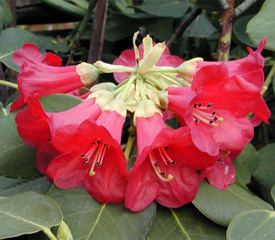
R. thomsonii is slow to flower. Flowers are 2-3" across, bell-shaped held in a loose truss of about 3-10 deep red flowers that have a contrasting large waxy cup-shaped calyx. This calyx can be whitish-green, yellowish-buff or greenish scarlet. The plant blooms in April.
R. thomsonii does best if planted in a location protected from the afternoon sun and late frosts.
Rhododendron catawbiense portrait
Common names: Purple Laurel, Rose Bay, Catawba Rhododendron.
R. catawbiense grows in the wild in the mountains of Virginia and West Virginia to Georgia and Alabama, occasionally eastward to near the coastal plain. They are evergreen shrubs or small trees. Leaves are thick, leathery, dark green above, pale green beneath, shaped oval or elliptic, 2" - 5" long.
Flowers held in an umbel-like cluster, colored rose-purple to lilac, rarely white, with olive-green spots on upper lobe, not fragrant. Flowers bloom in May and June. Calyx lobes broadly triangular or semicircular, less than 1/3" long. Corolla rotate to campanulate shape, up to 2 1/3" across. Ten stamens; filaments purple, anthers white. Purple style about as long as stamens.
Cold hardy to -25°F ( -32°C). Widely used by hybridizers to create cold-tolerant hybrid varieties.
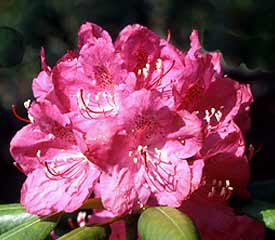
Photo by Rhododendron Species Foundation (ac77-620)
Rhododendron sargentianum
R. sargentianum, a dwarf rhododendron, was first introduced in 1903 by plant explorer Ernest Wilson who found it when he was hunting for plants in the mountains of western Szechwan, China. He found it a few other times growing in the same locality, in exposed areas, at elevations of nine to eleven thousand feet.
This is an ideal plant for a rock garden, or tucked into a little niche in your garden, because at maturity the plant is such a little gem. Plants grow to about 18 inches tall and about that wide; there may be some larger than that, but I've never seen one. They grow slowly but start blooming as small plants. Sometimes plants grown from cuttings will start blooming within two years. It is a twiggy compact plant with small aromatic leaves that are shiny green on top and densely covered with tiny rust colored or dark brown scales.
Typically this rhododendron species will bloom in April or early May. The flowers are small, narrowly tubular with spreading lobes that are held in little trusses of five to seven flowers. The flowers are either white, pale yellow, or lemon yellow. The yellow forms are in greatest demand, but many folks prefer the clones with white flowers.
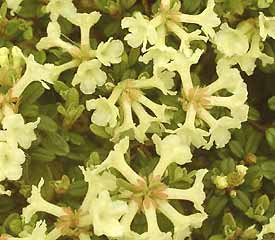
Photo by Ken Cox
This is an alpine rhododendron and, like most alpine rhododendrons, it is absolutely essential that it is grown in a medium with good sharp drainage and in an open location. However, try to provide it with afternoon shade, as it doesn't seem to like the hot sun.
R. sargentianum is one of the finest dwarf rhododendrons you can have in your garden. In the spring it will cover itself with a profusion of flowers and when it is not in flower it is still an attractive little shrub. Don't forget that fragrant foliage! R. sargentianum does not look like a "typical" rhododendron and will be certain to add interest and variety to your garden.
Rhododendron arboreum
R. arboreum is possibly the most widespread rhododendron in the world. The plants grow in the wild in southeast Asia occupying a wide arc on the southern slopes of the Himalaya Mountains, from Kashmir through Nepal, Sikkim, Bhutan, and Manipur, a distance of about 1,500 miles. In its native habitat some arboretum forms can grow up to 60 feet tall, but in cultivation, it rarely grows over 40 feet. Most experts say it will grow to be about 6 ft. tall in 10 years. So don't let its mature height keep you from planting one in your garden.
The leaves of R. arboreum are large; 4 to 8 in. long and up to 2 in. or more wide. They are thick and leathery. Arboreum leaves are glossy, deep green on top, with the underside covered with a thin plastered or woolly indumentum that varies in color between different subspecies. The color of the flowers varies considerably, from white to shades of pink or red. Some of the white and pink forms sometimes will have deeper colored spots which add to their interest and beauty. All have nectar pouches at the base of the flower. Flowers are bell-shaped and are held in trusses of 15 to 20 flowers. The blood-red forms are generally considered to be the most tender.
Since the British Empire previously occupied much of the area where R. arboreum grows, and much of the early rhododendron hybridizing occurred in the British Isles, the species has been often used as a hybrid plant parent. Arboreum seed was first sent back to Britain from Nepal almost 200 years ago. Some examples of hybrids where R. arboreum has been used as a parent include:
R. 'Bibiani', ('Moser's Maroon' x R. arboreum ssp. arboreum)
R. 'Cornubia', (R. arboreum ssp. arboreum, red form x Shilsonii Group)
R. 'Doncaster', (R. arboreum ssp. arboreum x unknown)
R. 'Loders White', (R. arboreum ssp. cinnamomeum var. album x R. griffithianum)
R. Nobleanum Group, (R. caucasicum x R. arboreum ssp. arboreum)
Rhododendron leucaspis
Last year while attending a local rock and alpine garden show, I saw Rhododendron leucaspis in bloom for the first time and it immediately went to the top of my wish list. I looked around for a plant locally without success and had to put it on the back burner. So time passes and a few months later, I'm on my way to the ARS western regional fall conference in Newport Oregon and on the way there I decided I wasn't going to buy any plants, (Yeah, right!) as I was going to be on the road for a few days before heading home, and didn't want to have to fuss with looking after plants and deal with the border crossing. But, wouldn't you know it, the first plant I spotted on the Rhododendron Species Foundation's sales table was R. leucaspis, and I just had to have it - so much for resolutions about not buying anymore plants!
The plant I saw at the rock and alpine show is wintered under cover. The grower, a fellow "rhodoholic", thinks it might be a bit tender here in Victoria and I didn't want to take any chances with my new plant, so I over-wintered it in my sunroom - probably a good idea as this past winter was longer and colder than we've had in awhile. I've since learned from others that they're able to grow R. leucaspis outside reliably, so it is probably totally hardy in zone 7. My new plant was loaded with flower buds and blooming started in mid-February. It finished blooming at the end of March and in addition to lovely white flowers, to my delight, the flowers had a light fragrance, most noticeable when the temperature rose.
R. leucaspis is a small plant with clear white flowers. The stamens are very dark and stand out against the white petals. The petals are slightly reflexed, giving the flowers a nice, open appearance. Flowers are about 2 inches across and are held two or three to a truss. The plant itself has "smallish", dark green, slightly hairy leaves which provide a wonderful background to the white flowers. The plant height is about 2 feet in ten years. Since it is a small plant, I intend to keep it in a container, at least for now.
There are lots of great reasons to attend the ARS conferences: nice people, good talks, wonderful gardens to visit and the plant sales. I have no regrets that I didn't stick to my resolution of not buying another plant! I've made the same resolution about not buying anything at the 2017 Eureka ARS Convention, but I wonder what treasures I'll find and just have to have?
Little Sweetheart Rhododendrons
Much as I love the big, bold, beautiful Rhododendrons, I have a small garden so I grow mostly small species and hybrids. Some of my all-time favourite species are R. pruniflorum, R. sargentianum and R. campylogynum. As container specimens, all have been reliably hardy for me in the Victoria area for many years and all are easy growers.
I started with small well-rooted cuttings, originally grown in 4 inch pots and over time, have moved the plants up to larger containers. The current pot size capacities are, more or less, 3 gallons. My potting mix is coarse peat, perlite, some coarse sand and if I've got it, a bit of garden compost. I do want a well-drained mix, so there's no more than about 40% peat in the mix. I know many people are cautious about fertilizing some Rhododendron species, but I give my container-grown plants a light application of slow release fertilizer in the early spring. Since they're in pots, there's considerable leaching so I think some fertilizer is appropriate. Some of our local growers just top dress their potted rhododendrons with Seasoil (a form of composted fish fertilizer) once each spring, and this works well for them.
I keep my plants in a location where they get full sun in the morning, but by about 1 pm, they are in the shade. Good light is needed to set flower buds, so if you have some of these smaller species and they're not blooming for you, perhaps a bit more light is in order. I water freely on an as needed basis, and I make sure the drainage holes remain open since there can be problems with containers if they're sitting directly on the soil surface where the holes may gradually get plugged. I like to have some sort of top-dressing on the soil surface to prevent too much surface compaction from all the watering I do. A good layer of orchid bark makes an attractive mulch, but sometimes I use turkey grit, or small-sized pea gravel. However, if you like to show your plants, most show judges prefer to see bark mulch used as a top-dressing as they often think write comments that they think gravel isn't aesthetically suitable for rhododendrons. Personally, I like the look of gravel or grit and it lasts longer than orchid bark.
Rhododendron pruniflorum has thimble-sized bell-shaped flowers of a dusty plum colour. It's absolutely adorable in bloom. The leaves are small, a nice dark green on top and white underneath. My 6-year old plant is about 18 inches tall and 18 inches wide. Many of us grow R. campylogynum and there are several forms available - all of them are very nice. But, my favourite (and I have a couple of forms) is R. campylogynum Leucanthum. Again, the thimble-sized flowers are bell-shaped, but in this case they are white in colour. Rhododendron sargentianum has small, ball-like trusses of white to ivory coloured tubular flowers. The tiny leaves are a nice shiny green and if crushed, give off a scent. The scent isn't unpleasant, but it makes me sneeze. I have a plant of the straight species, but recently acquired a plant of the selected variety 'Liz Ann' which is stunning in bloom as it just covers itself in pure white flowers. These plants are also about 18 x 18 inches and range in age from 3 to 7 years old.
A very similar looking plant to R. sargentianum is R. primuliflorum, but, with primuliflorum, the tubular flowers range in colour from white to soft pink and even yellow. It also has scented foliage. I've just recently been given a pink flowering form of R. primuliflorum and I'm looking forward to seeing it in bloom next spring.
One of the advantages of growing plants in pots is that I can move them onto the porch when the plants are in bloom, so while the plants and their flowers are small, I can get up close and personal with them easily. You know the adage, great things come in small packages, so if you only have a small garden, consider growing some of these lovely little sweethearts.
Rhododendron williamsianum
Rhododendron williamsianum, introduced to horticulturists of the western world in 1908 by Ernest "Chinese" Wilson is at once one of the most recognizable and one of the most enchanting rhododendrons. Its unique combination of almost orbicular, mid-green leaves, spreading and somewhat rounded or dome-shaped habit, and disproportionately large, candy-pink, campanulate flowers make it easy to recognize and well-adapted to gardens both large and small. Its densely mounded shape often has a somewhat brooding appearance, a bit like having a very large toadstool in the garden...but its solid presence makes a good anchor to a plant grouping, and can provide an effective screen, if needed.
Although never thought of as a large rhododendron, it can in time become quite massive, spreading up and out in large billowy curves that are certainly beyond the reach of vertically-challenged gardeners.
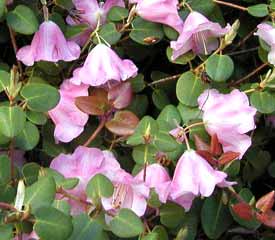
Photo by Chris Klapwijk
It was a species that has so captured the imagination of rhododendron fanciers that a veritable frenzy of hybridizing ensured. After all, there were so many positive characteristics to try to attach to other rhododendrons: small, tidy, glabrous leaves, with lovely bronze new growth, well-shaped, pretty pink blossoms that were large in relation to the leaf size, and a spreading compact habit that keep the blossom down where people could easily admire them.
Looking through Salley and Greer's book Rhododendron Hybrids, I gave up counting at the end of the C's, having reached something over 55 hybrids. Each decade seemed to bring on a new wave of williamsianum crosses:
- Rothschild in the early 30s, including the iconic hybrid 'Bow Bells'.
- Lord Aberconway in the late 30s and early 40s, with a whole series of hybrids beginning with "A" ('Adrastia', 'Adrean', 'Amata') as if he were trying to get in first in the Yellow Pages, but also developing the wonderful 'Cowslip', a williamsianum x wardii cross.
- Hobbie in the mid 40s, with his 'Gartendirektor(s) 'Glocker' and 'Reiger'
- all the way up to Weldon Delp and Hans Hachman's more recent hybrids.
- Even J. C . Williams of Caerhays Castle used this namesake rhodo in his inspired 'Hummingbird' cross with R. haematodes.
R. williamsianum is truly endemic to Sichuan, China, being found only there, and even within that province its distribution is very limited. However, it is now in constant and widespread production and cultivation all over the world.
Fragrant Rhododendron fortunei
Plant hunter Robert Fortune discovered this lovely species in 1855. It is a fragrant rhododendron...but unlike those sweetly scented, tender beauties lindleyi, nuttallii and maddenii, R. fortunei is quite hardy.
Fortune's original collections were made in Chekiang Province, in eastern China, at about 3,000 feet. Other plant hunters later found the species in Anhwei, Kiangsi, and Hunan Provinces growing in woods and forests at 2,000-4,000 feet in elevation. Plant hunter Robert Wilson noted that the species was common on other Chekiang mountains, particularly in the Lu Shan range of the neighboring province of Kiangsi, to the west.
The leaves of R. fortunei are handsome, and show some variation. They are 3 to 7 inches long, 1.5 to 3 inches wide. A prominent and very attractive feature is the deep red of the midrib and petioles (leaf stems); these create a ring of color around the dormant bud that seems to deepen and become more conspicuous in winter. The leaves of the Lu Shan form are typically a dull, olive green in color, and have rich red petioles.
The flowers of R. fortunei are borne in a loose truss of 5 to 12, and are shaped like wide bells...funnel-campanulate. They are pink to pale pinkish-lilac or rose and are fragrant.
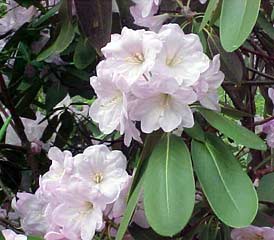
Photo by Boris Bauer
R. fortunei has been much used for hybridizing, particularly in North America, and especially in the East...where it is appreciated for its tolerance of summer heat and winter cold. The two great hybridizers, Rothschild and Dexter, made free use of it this rhododendron as a parent. Indeed, one of the most loved hybrids of all time in eastern North America is Dexter's 'Scintillation'.
It is noteworthy that a particularly fine large flowered, sweet-scented R. fortunei clone was used as the seed parent of the original 'Loderi' hybrid grex. The other parent is R. griffithianum; a tender rhododendron found growing in the lower elevations of the Himalayas.
Adapted from Whidbey Island ARS Chapter newsletter, May 2003
"A" is for Rhododendron albrechtii
I keep a wish list of rhododendrons I want, and at the moment, the species R. albrechtii is included in the top three of my list. I grew it in my old garden, but sadly, when I moved, it was one of the plants I had to leave behind. I haven't found a replacement plant for sale yet, but I keep looking, and after all, the hunt is almost as much fun as growing the plant. I may have to break down and order some seed of this species as it's not commonly available in the trade as established plants.
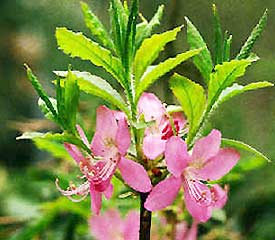
photo by Tijs Huisman
Why do I like it so much? Well, in bloom it's such a sweetheart! The plant I grew had deep cerise-pink flowers, two or three to a cluster, and each flower was almost 2 inches across in size. In doing a bit of internet searching, I see other growers report floral colours ranging from the deep rosy pinks into the purple reds, and up to 5 flowers per cluster. In the Pacific Northwest, R. albrechtii usually blooms in mid to late April.
The plant, native to Japan, is a deciduous azalea, and the leaves on my "old" plant turned a lovely yellow before they dropped in the fall. I'm not sure if fall leaf colour is a constant for all albrechtii plants, but it's nice when it happens. I had my plant situated on the north side of the house, but it got good light from mid-afternoon on into the evening. It prefers areas with cooler summer temperatures, so avoid planting sites that receive hot temperatures and mid-day sun. The usual recommendation of even soil moisture applies. Plants grow to a height of about 4 feet, so R. albrechtii is a good choice for the small garden, or even a large container. It's also a good choice for woodland plantings. Do keep an eye out for this great little plant – it should be on everyone's wish list.